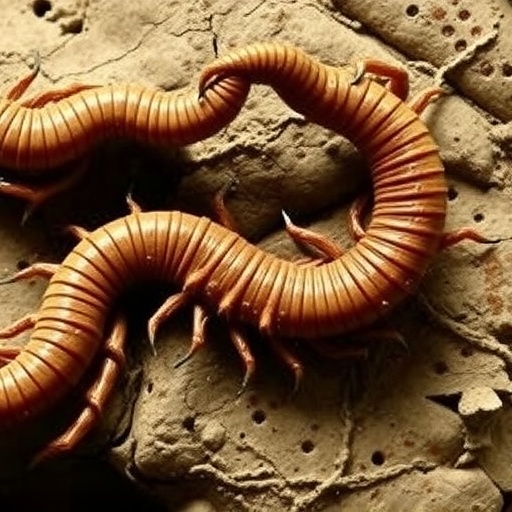A groundbreaking discovery in paleontology has drastically rewritten the timeline and ecological understanding of leeches, the annelid worms recognized today for their parasitic blood-feeding behavior. A fossil unearthed from the Waukesha biota formation in Wisconsin pushes back the origin of leeches by an astonishing 200 million years, revealing clues about their ancient lifestyle and evolutionary adaptations that were previously unknown to science.
This fossil, estimated to be approximately 430 million years old, represents the earliest known body fossil of the entire leech lineage, providing an unprecedented window into their Paleozoic past. Unlike modern leeches that commonly possess both front and rear suckers to facilitate their hematophagous feeding strategy, this specimen features a pronounced large caudal sucker at its tail end but conspicuously lacks the anterior sucker. This morphological trait strongly suggests a markedly different ecological niche for early leeches, which may have been marine predators or scavengers rather than blood-sucking parasites.
Leeches, classified within the clade Hirudinida, are renowned for their complex biological adaptations, including anticoagulants, specialized mouthparts, and enzymes necessary for hematophagy. The fossil’s anatomy implies that these complex features evolved later, with the earliest ancestors likely subsisting on soft-bodied marine invertebrates. This feeding behavior would involve swallowing prey whole or extracting internal fluids without penetrating the skin of larger vertebrate hosts, painting a picture of early leech ecology profoundly different from their modern descendants.
Preservation of soft-bodied organisms such as leeches in the fossil record is extraordinarily rare due to the absence of hard skeletal elements or protective exoskeletons. The Waukesha biota’s unique depositional environment, characterized by rapid burial, low oxygen levels, and unusual geochemical conditions, created the ideal circumstances for exquisite soft tissue fossilization. The discovery of this leech fossil is thus not only a remarkable paleontological find but also a testament to the exceptional preservation potential of the formation.
Previously, the scientific consensus placed the emergence of modern leeches during the Mesozoic era, roughly 150 to 200 million years ago. This fossil find, however, doubles that timeline, indicating that Hirudinida’s evolutionary origins extend deep into the Paleozoic. Such a revelation significantly alters our understanding of annelid evolution and highlights how much remains to be uncovered about the early diversification of complex life forms within marine ecosystems.
The fossil was identified through meticulous examination and collaboration across multiple institutions, including the University of California, Riverside, the University of Toronto, the University of São Paulo, and Ohio State University. Its initial discovery during a comprehensive investigation of the Waukesha site exemplifies the incremental yet transformative nature of paleontological research. The specimen caught the attention of paleontologists due to its distinctive segmentation and caudal sucker morphology, hallmark features characteristic of leeches.
Modern leech species are ecologically versatile, inhabiting freshwater, marine, and terrestrial environments with a range of feeding strategies from scavenging and predation to obligate parasitism. However, the fossil record’s lack of soft-bodied preservation has long hindered efforts to accurately trace the evolutionary trajectory of their diverse lifestyles. This newly described fossil thus fills a critical gap, providing direct evidence of early leech morphology and initial adaptations within the group.
Paleontologist Karma Nanglu, a leading researcher on this study, emphasizes the evolutionary complexity suggested by the fossil’s morphology. He notes that the absence of the anterior sucker and blood-feeding adaptations implies a simpler predatory mode in ancient marine environments. Such findings invite a reevaluation of the physiological milestones that ultimately led to the specialized hematophagy observed in modern species.
The discovery also underscores the broader scientific imperative to explore exceptional fossil sites and reexamine specimens with fresh perspectives. As the Waukesha biota continues to yield rare and significant body fossils of soft tissues, these findings illustrate the importance of integrating paleobiology, molecular data, and comparative morphology to assemble a cohesive picture of early animal evolution.
This leech fossil not only extends our phylogenetic knowledge but also acts as a catalyst for future research aimed at decoding the complexities of ancient ecosystems. It challenges previously held assumptions about the ecological roles leeches occupied and encourages scientists to consider alternative evolutionary pathways that may have preceded the contemporary parasitic model.
Ultimately, this discovery highlights the dynamic and oftentimes surprising nature of evolutionary history. The deep roots of the tree of life are continuously being uncovered, revealing an intricate web of biological innovation and adaptation. As researchers delve further into the fossil record and molecular evidence, our understanding of how complex life evolved and diversified in Earth’s oceans and beyond will become ever more refined.
The fossil itself stands as a spectacular specimen, uniquely preserved and extraordinarily informative. It not only informs us about the anatomy and lifestyle of prehistoric leeches but also symbolizes the serendipitous moments in scientific exploration when rare fossils offer profound insights, reshaping our understanding of life’s ancient past.
Subject of Research: Leeches (Hirudinida) evolution and early paleoecology
Article Title: (Not Provided)
News Publication Date: 1-Oct-2025
Image Credits: Andrew J Wendruff/Otterbein University and Takafumi Nakano/Kyoto University
Keywords: Animal fossils, Fossils, Paleontology, Fossil records, Macrofossils, Paleobiology, Paleoecology, Paleozoology, Earth sciences




